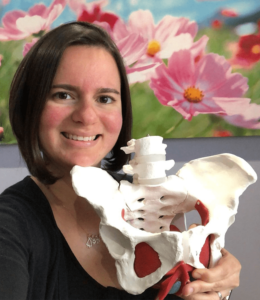What is Pelvic Floor Physiotherapy?
Pelvic floor Physiotherapy is a branch of orthopaedics manual therapy. It is a specialty focused on assessing and treating muscles, joints, connective tissues and nerves of the lower back, pelvis, hips and internal structures in the vagina and/or rectum.
Here I listed the top 3 reasons to see a pelvic floor Physiotherapist:
Urinary leakage:
Hands down, this is the most common symptom I treat. This is NOT normal. Did you know that 3.5 million Canadians suffer from some type of urinary incontinence? That is 10% of the population. There are 3 common misconceptions about urinary leakage: to think that it is normal to leak after childbirth, to think that it is normal as you age and to think that there is nothing you can do about the it.
Pain during intercourse:
Another very common symptom. Nobody should have pain during intercourse. There are several conditions that cause the pelvic floor muscles to become hypertonic (or tight). The most common conditions are: vaginismus (inability to have penetration due to spasms of the pelvic floor muscles), vulvodynia (chronic vulvar pain like stabbing and burning), and trauma such as an episiotomy during vaginal delivery.
Lower back pain:
Did you know that pelvic floor dysfunction and lower back pain are highly linked? There is a study that shows Urinary Incontinence was present in 78% of 200 women with lower back pain (Eliasson, 2008). In the practice, we encounter a lot of sciatica (pain that travels from your lower back down to your leg) and sacroiliac joint dysfunctions. This is part of our expertise. We often address lower back, pelvis, hips, pubic bone and tailbone pain as well.
One of the most important parts of my job is to educate. We have to break the stigma and the tabu. We have to talk about pelvic floor issues.


